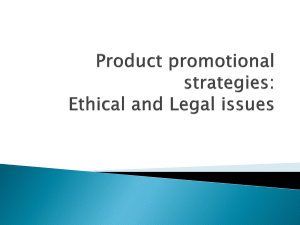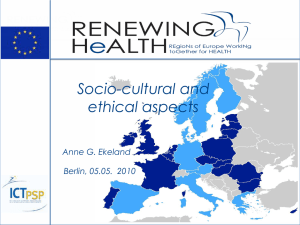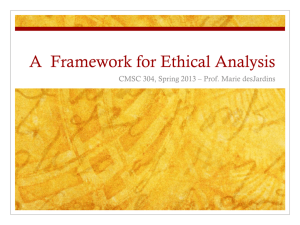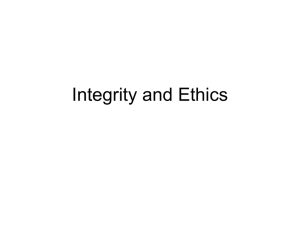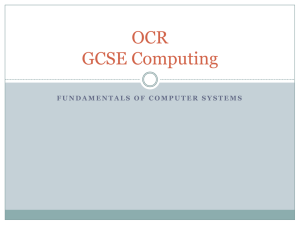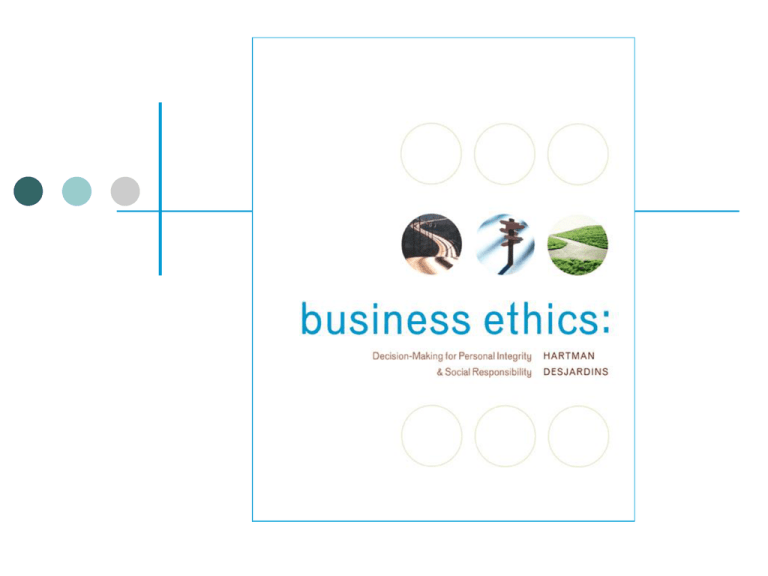
Chapter
2
Ethical Decision-Making: Personal
and Professional Contexts
McGraw-Hill/Irwin
Business Ethics: Decision-Making for Personal Integrity
& Social Responsibility
Copyright © 2008
2-2
1-2
The McGraw-Hill Companies, Inc. All rights reserved.
Chapter Objectives
After exploring this chapter, you will be able to:
1.
2.
3.
4.
Describe a process for ethically responsible decision-making
Apply this model to ethical decision points.
Explain the reasons why “good” people might engage in
unethical behavior
Explore the impact of managerial roles on the nature of our
decision-making.
2-3
1-3
An Ethical Decision-Making
Process: Click to explore each element
Determine the facts
Identify the ethical issues involved
Identify stakeholders and consider the situation from their point of view
Consider the available alternatives – also called “moral imagination”
Consider how a decision affects stakeholders, comparing and weighing
the alternatives, based on:
Consequences
Duties, rights, principles
Implications for personal integrity and character
Make a decision
Monitor outcomes
2-4
1-4
Determine the Facts
Making an honest effort to understand the situation, to
distinguish facts from mere opinion, is essential.
Knowing the facts and carefully reviewing the circumstances
can go a long way to resolving disagreements at an early
stage.
The sciences, and perhaps especially the social sciences, can
help us determine the facts surrounding our decisions.
How would this apply to the Opening Decision Point (the IPod)?
2-5
1-5
Identify the ethical issues
involved
A second step in responsible ethical decision making requires
the ability to recognize a decision or issue as an ethical
decisions or ethical issue.
It is easy to be led astray by a failure to recognize that there is
an ethical component to some decision.
In many business situations, what appears to be an ethical
issue for one person will be judged as a simple financial
decision by others.
How does one determine that an issue raises an ethical issue at all?
When does a business decision become an ethical decision?
2-6
1-6
Identifying Ethical Issues
We need to recognize that “business” or “economic” decisions and
ethical decisions are not mutually exclusive. Just because a decisions is
made on economic grounds does not mean that it does not involve ethical
considerations as well.
Being sensitive to ethical issues is an important characteristic that needs
to be cultivated in ethically responsible people.
We also need to ask how our decisions will impact the well-being of
the people involved.
To the degree that a decision affects the well-being—the happiness,
health, dignity, integrity, freedom, respect—of the people involved, it is a
decision with ethical implications.
2-7
1-7
Identifying Stakeholders
"Stakeholders" in this general sense includes all of the groups and/or
individuals affected by a decision, policy or operation of a firm or
individual.
Considering issues from a variety of perspectives other than one’s own,
and other than what local conventions suggest, helps make one’s
decisions more reasonable and responsible.
To the contrary, thinking and reasoning from a narrow and personal point
of view virtually guarantees that we will not have understood the
situation fully.
Making decisions from a narrow and personal point of view likewise
guarantees that we likely have made a decision that does not give due
consideration to other persons and perspectives.
2-8
1-8
Consider the Available
Alternatives
Creativity in identifying options – also called “moral
imagination” – is one element that distinguishes good people
who make ethically responsible decisions from good people
who do not.
It is important not to consider only the obvious options with
regard to a particular dilemma, but also the much more subtle
ones that might not be evident at first blush.
2-9
1-9
Compare and Weigh The
Alternatives
Create a mental spreadsheet that evaluates the impact of each alternative
you have devised on each stakeholder you identified.
Perhaps the most helpful way to accomplish this task is to try to place
oneself in the other person’s position.
Understanding a situation from another’s point of view, making an effort
to “walk a mile in their shoes,” contributes significantly to responsible
ethical decision-making.
Weighing the alternatives will involve predicting the likely, the
foreseeable, and the possible consequences to all of the relevant
stakeholders.
A critical element of this evaluation will be the consideration of ways to
mitigate, minimize, or compensate for any possible harmful
consequences or to increase and promote beneficial consequences.
2-10
1-10
Compare and Weigh the
Alternatives: Some options
But consequences or justifications are not the only means for comparing
alternatives. Some alternatives might concern matters of principles,
rights, or duties that override consequences.
Within business settings, individuals will often have specific duties
associated with their position. A purchasing manager for a large retail
store has a duty associated with her role that directs her to avoid conflicts
of interest in dealing with suppliers.
Are there duties associated with company rules, professional codes of
conduct, business roles, or legal duties involved?
Perhaps there is guidance available in specific circumstances from these
sources or others.
2-11
1-11
Compare and Weigh the
Alternatives: Some options
One additional factor in comparing and weighing alternatives requires
consideration of the effects of a decision on one’s own integrity and
character.
Understanding one’s own character and values should play a role in
decision-making.
A responsible person will ask: “What type of person would make this
decision?” What kind of habits would I be developing by deciding in one
way rather than another? What type of corporate culture am I creating
and encouraging? How would I, or my family, describe a person who
decides in this way? Is this a decision that I am willing to defend in
public?”
2-12
1-12
Making the Decision,
then Monitor it
It is time to make the decision.
An accountable decision requires the ability to offer a
justification or reason to support the decision. As a first step
in making ethically responsible decisions, one must be
prepared to offer reasons to support the decision.
To be accountable in our decision-making, we have a
responsibility to evaluate the implications of our decisions, to
monitor and then learn from the outcomes, and to modify
our actions accordingly when faced with similar challenges in
the future.
2-13
1-13
Why do “Good” People engage
in “Bad” Acts?
Sometimes, of course, people can simply choose to do
something unethical.
We should not underestimate the real possibility of immoral
choices and unethical behavior.
Sometimes, well-intentioned people fail to choose ethically.
This does not mean that these unethical decisions or acts are
excusable but that the individuals who engage in the unethical
behavior may have done so for a variety of reasons.
As it turns out, there are many stumbling blocks to
responsible decision-making and behavior. . . .
2-14
1-14
Explaining “Bad” Acts?
Cognitive or intellectual stumbling blocks: As suggested by the model of
ethical decision-making outlined above, a certain type of ignorance can
account for bad ethical choices.
Limitations: We sometimes only consider limited alternatives.
When faced with a situation that suggests two clear alternative
resolutions, we often consider only those two clear paths, missing the
fact that other alternatives might be possible.
Responsible decision making would require that we discipline ourselves
to explore additional methods of resolution.
Simplified decision rules are most comfortable to us: Having a simple
rule to follow can be reassuring to many decisions-makers.
Using a simple decision rule might appear to relieve us of accountability
for the decision, even if it may not be the best possible decision.
2-15
1-15
Explaining “Bad” Acts?
“Satisficing” - We also often select the alternative that
satisfies minimum decision criteria.
We select the option that suffices, the one that people can live
with, even if it might not be the best.
Issues of motivation and willpower:
As author John Grisham explained in his book, Rainmaker, “Every
(lawyer), at least once in every case, feels himself crossing a line
he doesn’t really mean to cross. It just happens.”
Sometimes it is simply easier to do the wrong thing.
2-16
1-16
Ethical Decision-Making in
Managerial Roles
Social circumstances can make it easier or more difficult to
act in accordance with one’s own judgment.
Within business, an organization’s context sometimes make it
difficult for even the best-intentioned person to act ethically,
or it can make it difficult for a dishonest person to act
unethically.
Responsibility for the circumstances that can encourage
ethical behavior and discourage unethical behavior falls to the
business management and executive team.
2-17
1-17
Managerial Roles
The decision-making model introduced in this chapter develops from the
point of view of an individual who finds herself in a particular situation.
Personal integrity lies at the heart of such individual decision-making:
what kind of person am I? What are my values? What do I stand for?
But every individual also fills a variety of social roles and these roles
carry with them a range of expectations, responsibilities, and duties.
Some of our roles are social: friend, son\daughter, spouse, citizen,
neighbor.
Some are institutional: manager, teacher, student body president.
Among the major role-responsibilities that we will examine in this text
are those associated with specific professions: attorneys, accountants,
auditors, financial analysts, etc.
2-18
1-18
Roles & Responsibilities in
Business
Decision-making in these contexts raises broader questions of
social responsibilities and social justice.
In a business context, individuals fill roles of employees,
managers, senior executives, board members.
Managers, executives, board members have the ability to create
and shape the organizational context in which all employees make
decisions.
They therefore have a responsibility to promote organizational
arrangement that encourage ethical behavior and discourage
unethical behavior.
2-19
1-19
Chapter Two Vocabulary Terms
After examining this Chapter, you should have a clear
understanding of the following Key Terms and you will
find them defined in the Glossary:
Accountability
Ethical decision-making process
Perceptual differences
Personal and professional decision-making
2-20
1-20

